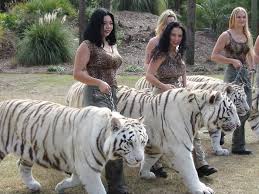animals, such as deer,
wild pigs and cattle. Small animals are also sometimes on the menu. Their coat
is orange with black stripes; however, color intensity and the pattern of
markings can vary according to species.
The Sumatran tiger is
the smallest and darkest of the subspecies, and the Siberian is the largest and
lightest in color. At one time, eight subspecies made up the tiger family, but
since the 1950s three have gone extinct. The five remaining species are
endangered due to poaching, loss of habitat and loss of prey due to overhunting
by humans.
Diet
Despite this, tigers remain
one of the most popular and recognizable creatures in the world. Here's several
interesting facts about them that may surprise you
Range
Historic
tiger range ran from Turkey through South and Southeast Asia to the far eastern
shores of the continent. Today, they are only found in South and Southeast
Asia, China and the Russian Far East.
Behavior
Tigers occupy a variety of habitats from
tropical forests, evergreen forests, woodlands and mangrove swamps to grasslands
savannah and rocky country. They are mostly nocturnal (more active at night)
and are ambush predators that rely on the camouflage their stripes provide.
Tigers use their body weight to knock prey to the
The tiger is the largest member
of the felid (cat) family. They sport long, thick reddish coats with white
bellies and white and black tails. Their heads, bodies, tails and limbs have
narrow black, brown or gray stripes. There were once nine subspecies of tigers:
Bengal, Siberian, Indochinese, South Chinese, Sumatran, Malayan, Caspian, Javan
and Bali. Of these, the last three are extinct, one is extinct in the wild, and
the rest are endangered.
Population
In
the early 1900s, there were around 100,000 tigers throughout their range.
Today, an estimated total of around 3,000-4,500 exist in the wild. Below is a
breakdown of tiger numbers by subspecies.
Bengal tiger: Less than 2,000
Indochinese tiger: 750-1,300
Siberian tiger: Around 450
Sumatran tiger: 400-500
Malayan tiger: 600-800
South Chinese tiger: Extinct in the wild
Caspian tiger: Extinct
Javan tiger: Extinct
Indochinese tiger: 750-1,300
Siberian tiger: Around 450
Sumatran tiger: 400-500
Malayan tiger: 600-800
South Chinese tiger: Extinct in the wild
Caspian tiger: Extinct
Javan tiger: Extinct